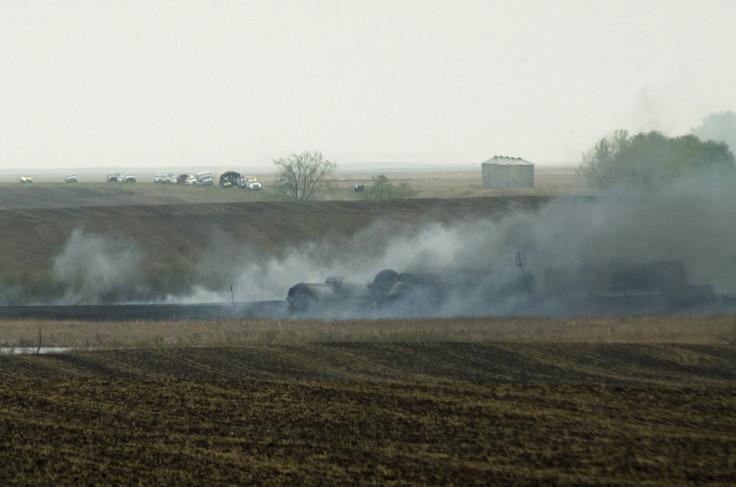Oil Trains: Crude Oil Involved In North Dakota Train Derailment And Fire Was Less Flammable Than State Limits

North Dakota’s new rules to limit the flammability of crude oil carried by trains weren’t strong enough to prevent a fiery explosion in the state this week, test results show. The BNSF train that derailed Wednesday and caught fire was carrying crude with lower volatility than required by state limits, Reuters reported Friday.
Test results sent to federal investigators and seen by Reuters showed North Dakota’s rule, which took effect last month, did not significantly reduce the risk of fireballs in accidents involving crude oil trains. In the crash, near the town of Heimdal, the crude on board contained about 20 percent fewer volatile gases than mandated by new regulations, Reuters said.
North Dakota now requires crude oil to have a vapor pressure of 13.7 pounds per square inch. The oil involved in Wednesday’s crash had a vapor pressure of just 10.83 psi, according to federal test results.
North American railroads are moving greater volumes of crude as drillers increasingly tap U.S. shale oil resources, particularly in the Bakken Shale region of North Dakota. Existing pipeline infrastructure isn’t sufficient to carry all the added crude to market, so companies are increasingly turning to trains for transportation.
U.S. railcars moved around 3.7 million barrels of crude oil last year, more than 15 times the amount moved by rail in 2010, U.S. Energy Information Administration data show. Over that time, the accidents have piled up, raising safety concerns among federal and state regulators about the types of tankers carrying the crude and the volatility of the fuel itself.
The North Dakota derailment is the fifth fiery incident since February involving oil-hauling tank cars. In West Virginia, a CSX freight train derailed earlier this year, launching fireballs 300 feet in the air and dumping crude into a river. The accident came just days after a 100-car oil train derailed in northern Ontario, with seven cars catching fire in a remote wooded area. Wednesday’s accident in North Dakota forced the evacuation of 40 residents in Heimdal. No one was injured.
The U.S. Department of Transportation in April placed a 40 mile per hour speed limit on trains transporting crude oil through major cities such as New York, Chicago and Seattle. Last week, U.S. and Canadian transportation officials announced a coordinated plan to replace older tanker cars with newer models and retrofit existing tankers to better deter derailments and explosions.
In North Dakota, critics of the state’s new limits on oil flammability said the Heimdal derailment shows the limits should be far tougher, Reuters reported.
However, state officials said the aftermath of this week’s accident was far less devastating than in previous episodes. “I’m happy with the condition of the oil in those tank cars, with the oil out in the field and the oil leaving North Dakota,” Doug Goehring, North Dakota’s agriculture commissioner and one of the three members of the state’s Industrial Commission, which crafted the rules, told the news agency.
© Copyright IBTimes 2024. All rights reserved.





















